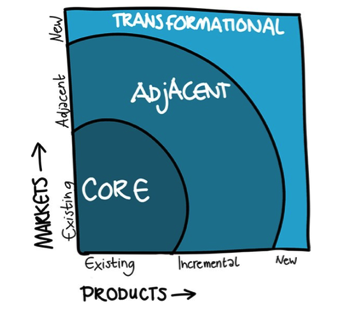Peter Moore reports:
Deploying digital technology with its connectivity to leverage underutilized assets is the new business model for profitable growth. Without having to spend their capital to own assets, they can access incremental adjacent assets at minimal marginal costs. Replacing high-cost physical assets like data centers with pay-as-you-go web services from Amazon, Microsoft or Google can dramatically lower the cost of entry into adjacent industries and new businesses.
- The most sustained, profitable growth came from companies that pushed the boundaries of their core business into adjacent space.
- Companies consistently and profitably outgrew their competitors by expanding those boundaries in predictable and repeatable ways.
The challenge for any
well-established companyAsset deployment vs. Asset ownership
In addition, replacing high cost physical assets like data centers with pay as you go web services from Amazon, Microsoft or Google can dramatically lower the cost of entry into adjacent industries and new businesses.
Utilizing this new business model approach also opens up opportunities for companies to start offering their products as subscription services such as:
The subscription e-commerce market has grown more than 100 percent a year for the last 5 years.
- Gillette On Demand & Dollar Shave Club
- Spotify, Netflix and Hulu
- Adobe, Salesforce & Workday
- Atlas Coffee Club, Stitch Fix & Hello Fresh
Getting started: Build an outside-in market centric perspective
- How much competitive advantage does your company have in each of its current businesses?
- How sustainable is your current market share?
- How strong is your pricing power with customers?
- How committed are your supply chain partners to your company?
- How can your company effectively leverage digital technology to enter adjacent markets and businesses?
- How can the company deploy systems of engagement to enter adjacent markets?
- Who will design and develop your next generation of offers?
- For whom will they be designed and developed?
- How can the company utilize systems of intelligence to evaluate adjacent market and new business opportunities?
- Who will be your new reference competitors?
- How will you be able to differentiate against these competitors on a sustainable basis?
- How capable is your company of competing as a digital enterprise?
- How will you develop or recruit the relevant skills and capabilities needed to compete?
- How will you incent achieving long term growth while sacrificing short terms results?
- How can you partner with other companies to enter adjacent markets?
How some companies have used technology to get into adjacent markets and businesses
Standing pat is not an option


























0 comments:
Post a Comment